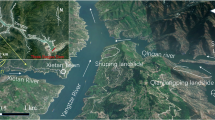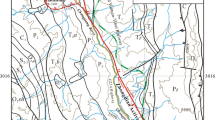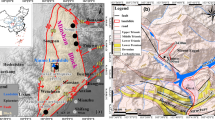Abstract
During the May 12, 2008 Wenchuan earthquake, rock masses in the earthquake region were shaken, and subsequently, a number of post-earthquake landslides and debris flows occurred, triggered by heavy rainstorms. This paper presents a study of the rainfall-induced mechanism that triggered the landslides. This study is based on pre- and post-landslide geomorphology and geological features identified from pre-landslide high-resolution satellite imagery and post-landslide aerial photographs of the Wulipo landslide. The remote sensing observations were verified by field investigations. The results indicate that the heavy storm that occurred in July 2013 was the main trigger for the landslide although existing tensions and weak rock interfaces were the main internal causes for reactivation of the landslide. The bedding in the rocks dips in the same direction as the topographic slope. A tensile trough developed at the scarp. Based on data from the Wulipo rockslide, a model is proposed for calculating the safety factor for rockslides that takes into account the hydrostatic pressure along the structural plane of the rockslide. The results show that the proposed method can effectively estimate the stability of a storm-induced rockslide in regions underlain by bedded rocks. Based on this estimate, it is concluded that the Wulipo rockslide is a reactivated old rockslide.










Similar content being viewed by others
References
Chai B, Jiang B, Du J, Xiao LL (2016) Diagrammatize movement disintegration patterns of bedding rockslide. Environ Earth Sci 75:323–338
Hoek E, Bray J (1981) Rock slope engineering, 3rd edn. The Institution of Mining and Metallurgy, London
Kliche CA (1999) Rock slope stability. Society for Mining Metallurgy, Littleton
Luo Q, Li L, Zhao LH (2010) Quasi-static analysis on the seismic stability of anchored rock slope with the effect of surcharge and water pressure conditions. Rock Soil Mech 31:3585–3593 (in Chinese)
Palenzuela JA, Jiménez-Perálvarez JD, Chacón J, Irigaray C (2016) Assessing critical rainfall thresholds for landslide triggering by generating additional information from a reduced database: an approach with examples from the Betic Cordillera (Spain). Nat Hazards 84(1):185–212
Sharma S, Raghuvanshi TK, Anbalagan R (1995) Plane failure analysis of rock slopes. Geotech Geol Eng 13(2):105–111
Shu JS, Wang XZ, Zhou YY (2004) Improving on assumption for water pressure distributing on failure surface in rock slope. J China Univ Min Technol 33:509–512
Shukla SK, Hossain MM (2011) Analytical expression for factor of safety of an anchored rock slope against plane failure. Int J Geotech Eng 5(2):181–187
Shukla SK, Khandelwal S, Verma VN, Sivakugan N (2009) Effect of surcharge on the stability of anchored rock slope with water filled tension crack under seismic loading condition. Geotech Geol Eng 27(4):529–538
Wu HB, He ZP, Cao WW (2011) Stability study of slope with planar failure based on different water pressure distributions. Rock Soil Mech 32:2493–2499 (in Chinese)
Wyllie DC, Mah CW (2004) Rock slope engineering, 4th edn. Spon Press, London
Yin YP, Cheng YL, Liang JT, Wang WP (2016) Heavy-rainfall-induced catastrophic rockslide-debris flow at Sanxicun, Dujiangyan, after the Wenchuan Ms 8.0 earthquake. Landslides 13(1):9–23
Zhao LH, Cao JY, Zhang YB, Luo Q (2015) Effect of hydraulic distribution on the stability of a plane slide rock slope under the nonlinear Barton-Bandis failure criterion. Geomech Eng 8(3):391–414
Acknowledgements
The authors would like to thank the Basic Research Program of China (No. 2013CB733200), the Creative Research Groups of China (No. 41521002), and the National Natural Science Foundation of China (No. 41672282) for grants that made this research possible. The first author would also like to thank the Innovation Team of the Chengdu University of Technology.
Author information
Authors and Affiliations
Corresponding author
Rights and permissions
About this article
Cite this article
Wu, L.Z., Shi, J.S. & Xu, Q. The rainfall-induced Wulipo rockslide, China: a modified model for rockslide initiation. Environ Earth Sci 76, 497 (2017). https://doi.org/10.1007/s12665-017-6826-z
Received:
Accepted:
Published:
DOI: https://doi.org/10.1007/s12665-017-6826-z




